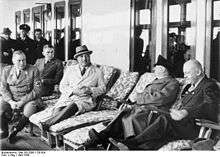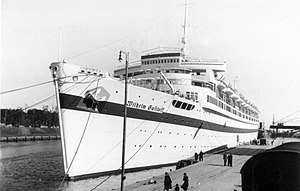Strength Through Joy
Kraft durch Freude (German for Strength through Joy, abbreviated KdF) was a state-operated leisure organization in Nazi Germany.[1] It was a part of the German Labour Front (Deutsche Arbeitsfront, DAF), the national German labour organization at that time. Set up as a tool to promote the advantages of National Socialism to the people, it had become the world's largest tourism operator by the 1930s.[2]
Kraft durch Freude | |
 | |
| Formation | 1933 |
|---|---|
| Extinction | 1939 (due to outbreak of WWII) |
| Type | Governmental organization |
| Purpose | Promote Nazism through subsidized leisure activities and holidays |
| Location | |
Parent organization | German Labour Front |
Staff | 7,000 (1939) |
Volunteers | 125,000 (1939) |
KdF was supposed to bridge the class divide by making middle-class leisure activities available to the masses.[3]
It also sought to bolster the German tourist industry, something it did successfully up until the outbreak of World War II. By 1934, over two million Germans had participated in a KdF trip; by 1939 the reported numbers lay around 25 million people. With the outbreak of war in 1939, the organization was mothballed, and several projects, such as the Prora holiday resort, were never completed.
Activities


Starting in 1933, KdF provided affordable leisure activities such as concerts, plays, libraries, day trips and holidays.[1] Large ships, such as Wilhelm Gustloff, were built specifically for KdF cruises. They rewarded workers with taking them and their families to the movies, to parks, keep-fit clubs, hiking, sporting activities, film shows and concerts. Borrowing from the Italian fascist organization Dopolavoro "After Work", but extending its influence into the workplace as well, KdF rapidly developed a wide range of activities, and quickly grew into one of Nazi Germany's largest organizations. The official statistics showed that in 1934, 2.3 million people took KdF holidays. By 1938, this figure rose to 10.3 million.[4]
Two weeks after the Anschluss, when SS-Gruppenführer Josef Bürckel became Reichskommissar für die Wiedervereinigung (Reich Commissioner for Reunification) as well as Gauleiter, the first five trains with some 2,000 Austrian workers left for Passau, where they were ceremonially welcomed. While Bürckel announced that he did not expect all KdF travellers to return as National Socialists, he did expect them to look him in the eyes and say, "I tried hard to understand you."[5]
The National Socialists sought to attract tourists from abroad, a task performed by Hermann Esser, one of the Ministry of Public Enlightenment and Propaganda's (Ministerium für Volksaufklärung und Propaganda) secretaries. A series of multilingual and colourful brochures, titled "Deutschland", advertised Germany as a peaceful, idyllic, and progressive country, on one occasion even portraying the ministry's boss, Joseph Goebbels, grinning in an unlikely photo series of the Cologne carnival.[6]
The KdF was awarded the 1939 Olympic Cup by the International Olympic Committee.[7]
At the outbreak of war, holiday travel was stopped. Until then KdF had sold more than 45 million package tours and excursions.[8] By 1939, it had over 7,000 paid employees and 135,000 voluntary workers, organized into divisions covering such areas as sport, education, and tourism, with wardens in every factory and workshop employing more than 20 people.

The "People's Car"

The KdF's most ambitious programme for German workers was set up for production of an affordable car, the "KdF-Wagen", which later became the Volkswagen Beetle (Volkswagen being German for "People's Car"). This was originally a project undertaken at Hitler's request by the engineer Ferdinand Porsche. When the German car industry was unable to meet Hitler's demand that the Volkswagen be sold at 1,000 Reichsmarks or less, the project was taken over by the German Labour Front (Deutsche Arbeitsfront, DAF). Now working for the DAF, Porsche built a new Volkswagen factory at Fallersleben, at a huge cost which was partly met by raiding the DAF's accumulated assets and misappropriating the dues paid by DAF members. The Volkswagen was sold to German workers on an installment plan where buyers of the car made payments and posted stamps in a stamp-savings book, which when full, would be redeemed for the car. Due to the shift of wartime production, no private citizen ever received a "Kdf-Wagen" (although after the war, Volkswagen did give some customers a 200 DM discount for their stamp-books). The Beetle factory was primarily converted to produce the Kübelwagen (the German equivalent of the Jeep). The few Beetles that were produced went to the diplomatic corps and military officials.[9]
After work
Feierabendgestaltung (English: After-work organization) was the "planned" structuring of daily leisure time within the KdF programme, attempted by the National Socialists through individual state agencies, including the Office for After-Work Activity (Amt Feierabend) and the Office for Popular Education (Amt Volksbildungswerk).[10] In National Socialist usage, the term "after-work organization" was increasingly applied to the entire area of organized leisure activity (including holidays).

Other uses of the name
The 2017 novel Star Wars: Leia, Princess of Alderaan originally used the phrase "Strength through joy" as an Alderaanian proverb. The resulting controversy on social media led to an apology from Disney-Lucasfilm Press and author Claudia Gray, stating that they had not been aware of the phrase's real-world history before publication. Subsequent editions changed the proverb to "Joy drives out fear."
See also
- German labour law
- Volksflugzeug (People's Aircraft)
References
- Richard Grunberger, The 12-Year Reich, p 197, ISBN 0-03-076435-1
- "Wellness unterm Hakenkreuz". Spiegel Online (in German). 19 July 2007.
- Richard Grunberger, The 12-Year Reich, p 197-8, ISBN 0-03-076435-1
- Mason, T.W., Social Policy in the Third Reich: The Working Class and the 'National Community'(Oxford: Berg. 1993), p. 160
- Anna Rosmus Hitlers Nibelungen, Samples Grafenau 2015, pp. 142f
- "Shown here, Goebbels at right". spiegel.de. Archived from the original (JPG) on 2018-08-31.
- Juergen Wagner. "The olympic cup". olympic-museum.de. Archived from the original on 2006-06-23. Retrieved 2006-10-15.
- Hasso Spode, Some quantitative aspects of Kraft-durch-Freude-tourism. In: Dritsas, Margerita (ed.): European Tourism and Culture, Athens 2007, p.125
- Tooze, Adam (2006). The Wages of Destruction: The Making and Breaking of the Nazi Economy. London: Allen Lane. ISBN 978-0-7139-9566-4.
- Wilson, Hugh R. (August 1938). "Summary of Report on Strength Through Joy: The Organization of Leisure Time". Franklin D. Roosevelt Library and Museum. Retrieved 14 September 2016.
External links
| Wikimedia Commons has media related to Kraft durch Freude. |
- Kraft durch Freude at Lebendiges Museum Online (German)
- Leisure Time - Life in Nazi Germany 1933-9 (PDF) (from the schoolhistory.co.uk website)